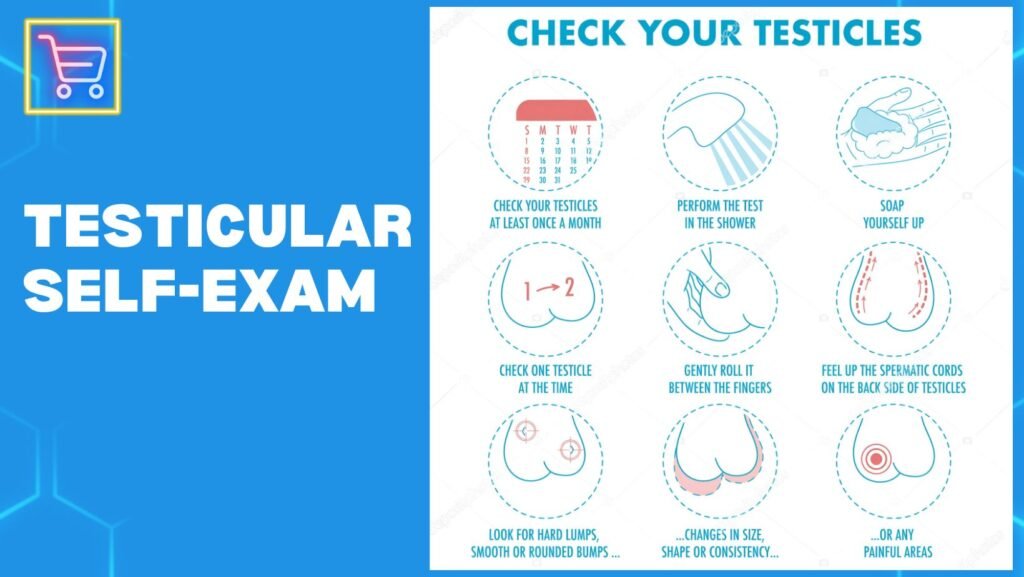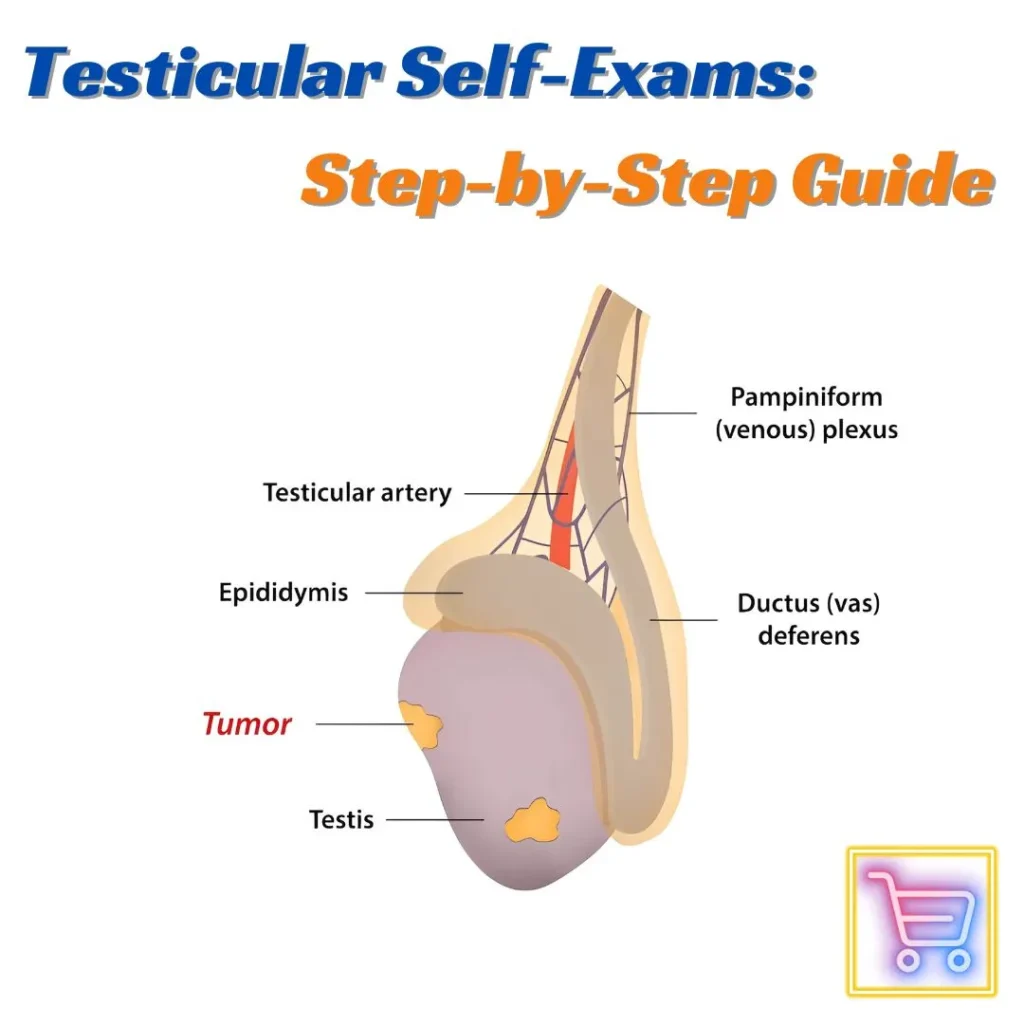Introduction
Testicular cancer is more common than you might think. It affects about 1 in 250 men over their lifetime. This shows why it’s so important for men to do regular testicular self-exams, starting at 15 years old.
A serene bathroom scene focused on a modern, well-lit mirror reflecting natural light, with soft pastel colors. The counter features a small bowl of organic skincare products, and a subtle hint of calmness prevails in the atmosphere. A towel hangs neatly, and an elegant plant adds a touch of nature, creating a tranquil environment conducive to personal health routines. The overall composition suggests a sense of self-care and well-being.
Doing a monthly testicular self-exam can help find problems early, like testicular cancer. Finding it early is key because it’s very treatable. If caught early, the survival rate is over 95%.
Table of Contents
Key Takeaways
- Testicular cancer affects 1 in 250 men during their lifetime.
- Testicular self-exams should start at age 15 and be performed monthly.
- Early detection through self-exams leads to better treatment outcomes.
- Testicular cancer is highly treatable, with a 95% five-year survival rate when caught early.
- Regular self-checks can help identify abnormalities and changes in the testicles.

Understanding Testicular Cancer Statistics
Testicular cancer is rare but very important for men’s health. It affects about 1 in 250 men over their lifetime. This makes it a big concern for men.
Who Is Most at Risk
Men aged 25-34 are most likely to get testicular cancer. It can happen to men of all ages. Risks include undescended testicles, family history, and HIV/AIDS. Also, Caucasian men face a higher risk than others.
Prevalence in Different Age Groups
Testicular cancer is common in men 20 to 39 years old. The highest rates are in men 25 to 34 years old. The average age of diagnosis is 36, showing it mainly affects the young.
Survival Rates and Early Detection Benefits
Testicular cancer is very treatable. If caught early, the five-year survival rate is over 95%. Early detection and medical check-ups are key. The only sure way to diagnose it is by removing the testicle surgically.
| Key Testicular Cancer Statistics | Value |
|---|---|
| Lifetime risk of developing testicular cancer | 1 in 250 men |
| Overall 5-year survival rate (if detected early) | Over 95% |
| Increased risk for men with undescended testicle | 4-6 times higher |
| Increased risk for men with family history | 8-12 times higher |
| Increased risk for Caucasian men | Higher incidence |
| Increased risk for men with prior testicular cancer | 12 times higher |
Knowing the testicular cancer statistics helps men stay healthy. It encourages men’s health awareness and early detection of testicular cancer. This can greatly improve survival chances and outcomes.
The Importance of Monthly Testicular Self-Exams
Good reproductive health is key for men. Regular testicular self-exams help check testicular health. These exams can spot testicular cancer and other issues early.
Testicular cancer hits men aged 15 to 35 hard. Monthly testicular self-exams boost the chance of catching it early. Dr. Michael Read stresses the need for men to check themselves regularly.
“Monthly testicular self-exams are the best way for men to become familiar with the normal feel of their testicles, making it easier to detect any changes that could signal a health issue. Early detection is key, as testicular cancer is highly curable when caught early.”
There’s no set rule for testicular cancer screening. But, self-exams help men stay on top of their health. By doing monthly self-exams, men can protect their reproductive health.
Common Risk Factors and Warning Signs
Knowing the risk factors and warning signs of testicular cancer is key. It helps catch the disease early and treat it effectively. While we don’t know all the causes, research has found important risk factors.
Genetic and Family History Considerations
Men with a family history of testicular cancer are at higher risk. This is true if a father or brother has had it. Also, if you’ve had testicular cancer before, you’re 12 times more likely to get it again.
Physical Symptoms to Watch For
- Painless lumps or swelling in the testicles
- Changes in the size, shape, or texture of the testicles
- Dull ache or discomfort in the lower abdomen or groin area
- Fluid buildup in the scrotum
Environmental and Lifestyle Factors
Some studies link certain chemicals, radiation, and a sedentary lifestyle to testicular cancer. But the exact link is not clear. Regular self-exams are vital for catching changes early.
Having risk factors or warning signs doesn’t mean you’ll get testicular cancer. Regular checkups are important. They help catch the disease early and treat it right away.
“Early detection is key when it comes to testicular cancer. Men should perform regular testicular self-exams and report any changes or concerns to their healthcare provider immediately.”
Testicular Self Exam: Essential Guide
Doing regular testicular self-exams is key to keeping healthy. This easy step can spot any oddities in your testicles. It might even catch testicular cancer early.
The best time for a testicular self-exam is after a warm bath or shower. Your scrotum will be relaxed. Here’s how to do it right:
- Stand in front of a mirror and look at your testicles. Check for swelling or size changes.
- Roll each testicle gently with your thumb and fingers. Feel for lumps or odd feelings.
- Check the epididymis and vas deferens too. These are at the back and carry sperm.
- Notice if one testicle looks different from the other. Some size differences are normal.
It’s important to know what your testicles usually feel and look like. This way, you can spot any changes. If you find something odd, get it checked by a doctor right away.
Adding testicular self-exams to your monthly routine is a smart move. It’s a simple way to look after your health and catch problems early. By doing this regularly, you help keep your testicular health in check.

Best Practices for Regular Monitoring
It’s important for men to check their testicles regularly. Experts say to do the testicular self-exam every month. This helps catch testicular cancer early, which is key to treating it well.
By following a few easy steps, men can check themselves well. They can also watch for any changes or worries.
Optimal Time and Conditions
The best time to check your testicles is after a warm shower. This is when your muscles are relaxed. Stand in front of a mirror and use both hands to gently feel each testicle.
Roll each testicle between your thumb and fingers. Look for any lumps or swelling that’s not normal.
Documentation and Tracking Methods
- Keep a record of your monthly testicular self-exams, noting the date and any observations or changes.
- Consider using a calendar or smartphone app to set reminders and track your self-exam routine consistently.
- Documentation can help identify patterns and detect any abnormalities early on.
Regular testicular self-examination techniques and a consistent men’s health routine are key. They help keep you healthy. By being careful and proactive, men can help find problems early. This increases the chances of successful treatment.
“Early detection is key and contributes to higher curability rates, even in the early stages of the disease.”
Identifying Normal Versus Abnormal Findings
Checking your testicles regularly is key to spotting any unusual changes or signs of testicular cancer. But how do you tell if a testicle is normal or if it needs a doctor’s visit? Let’s explore what to look for during your monthly self-exams.
A healthy testicle should feel oval-shaped, smooth, and firm. It’s okay if one is a bit bigger than the other. You might also feel a soft, rope-like structure behind it, which is the epididymis. This is normal and nothing to worry about.
But, abnormal findings that need a closer look include:
- Hard lumps or nodules
- Significant changes in the size or texture of the testicle
- Persistent pain or discomfort
- Sudden changes in how the testicle feels
If you find any testicular lumps and bumps, see a healthcare professional right away. Most testicular lumps are not cancerous. But, it’s important to get a doctor’s opinion to check for any issues.
Knowing what does a normal testicle feel like is vital for doing effective self-exams. By knowing what’s normal, you can spot any unusual changes that might need medical attention.

When to Seek Medical Attention
Early detection is key for testicular health. If you see unusual changes or feel ongoing discomfort, get medical help fast. Look out for these warning signs:
- Lumps or swelling in the testicles
- Sudden changes in the size or texture of the testicles
- Persistent pain or heaviness in the scrotum
- Fluid buildup in the scrotum
Emergency Warning Signs
Some testicular issues need immediate care. Sudden, severe pain in the testicles or scrotum is a red flag. It could mean testicular torsion, where the testicle twists off, cutting off blood. Quick action is vital to avoid permanent harm or losing the testicle.
Professional Examination Process
Your healthcare provider will do a detailed physical check, including a testicle exam. They might also run tests like an ultrasound or blood work. This thorough check is key to finding the cause and the right treatment.
Testicular cancer is rare but can happen to any man. By doing testicular self-exams and getting medical help when needed, you boost your chances of catching it early. This can lead to better treatment results.
Breaking the Stigma: Men’s Health Awareness
It’s important to talk openly about men’s reproductive health. Discussing testicular health and self-exams helps make them normal. Events like Testicular Cancer Awareness Month in April help a lot.
In the U.S., many efforts are underway to raise awareness. For example, the Birdies for Balls campaign raised $10,000 for the Testicular Cancer Foundation in 2022. The South Carolina Gamecocks football team also donated $5,000 to the same cause.
SAXX gave $1,000 for every sack of the quarterback by the Gamecocks. They also donated $1,000 for every birdie made by the caddies’ players during the Travelers Championship. Plus, they gave an extra $5,000.
Testicular cancer is rare, affecting only 1 in 250 men. It often strikes between 15 to 44 years old. So, men should do monthly self-exams. By talking more about this, we can help men feel more in control of their health.
FAQ About Testicular Self-Exam
What is the importance of regular testicular self-exams?
Testicular self-exams are key for catching problems early. Men should check their testicles once a month from age 15. If caught early, testicular cancer is very treatable, with a survival rate over 95%.
Who is most at risk for developing testicular cancer?
Testicular cancer hits 1 in 250 men over their lifetime. It’s most common in men aged 15-44, with the highest rates in the 25-34 age group. Risk factors include cryptorchidism, family history, and race, with Caucasian men at higher risk.
How do regular testicular self-exams help monitor testicular health?
Monthly self-exams help spot testicular cancer and other issues early. They help men get to know their testicles’ normal feel. This makes it easier to notice any changes. Self-exams are the best way to keep an eye on testicular health, as there are no routine screening guidelines for testicular cancer.
What are the common risk factors and warning signs for testicular cancer?
Risk factors include age (15-44), cryptorchidism (4-6 times higher risk), family history (8-12 times higher risk with affected father or brother), and personal history (12 times higher risk in the other testicle). Common symptoms include painless lumps, swelling, pain or discomfort, changes in texture, dull ache in the groin or lower abdomen, and fluid buildup in the scrotum.
How should a testicular self-examination be performed?
Do the exam after a warm bath or shower when the scrotum is relaxed. Look for swelling or changes in size or shape. Gently roll each testicle between thumb and fingers, feeling for lumps, bumps, or unusual changes. Check the epididymis and vas deferens. Look for any differences between testicles, noting that slight size variations are normal.
When and how often should men perform self-exams?
Do self-exams monthly in a warm, relaxed environment. Stand in front of a mirror for visual inspection. Use both hands to examine each testicle separately. Keep a record of your examinations, noting any changes or concerns. Consider using a calendar or smartphone app to set reminders and track your self-exam routine.
What does a normal, healthy testicle feel like?
Normal testicles are oval-shaped, smooth, and firm, with one slightly larger than the other. The epididymis should feel like a soft, rope-like structure behind the testicle. Abnormal findings include hard lumps, significant changes in size or texture, persistent pain or discomfort, and any sudden changes in how the testicles feel.
When should someone seek medical attention for testicular concerns?
Seek immediate medical attention for any lumps, swelling, or changes in testicle size or texture. Other warning signs include persistent pain, heaviness in the scrotum, or sudden fluid buildup. A healthcare provider will perform a physical exam and may order ultrasound or blood tests for further evaluation. Early consultation is key for effective treatment.
Why is it important to overcome the stigma surrounding men’s reproductive health?
It’s vital to break down the stigma around men’s reproductive health. Talking openly about testicular health and self-exams can make them seem normal. Education and awareness campaigns, like Testicular Cancer Awareness Month in April, help in this effort. They encourage men to take an active role in their health maintenance.
Conclusion
Taking charge of your testicular health is a simple yet powerful way to protect your overall well-being. By incorporating a monthly testicular self-exam into your routine, you’re not just checking off another task—you’re prioritizing yourself. Think about it: how much time do you spend caring for other aspects of your health? Just a few minutes each month can make a life-changing difference when it comes to early detection and prevention.
So, as you move forward, ask yourself: Am I making my health a priority? Taking this small but crucial step can provide peace of mind and potentially save your life. Remember, understanding what’s normal for your body is the key to recognizing when something might not be right.
If you notice anything unusual—lumps, swelling, or discomfort—don’t hesitate to consult a healthcare professional. Early action is the best defense against serious conditions like testicular cancer.
You’ve got the knowledge, now make it a habit. Let’s break the stigma, start conversations, and encourage the men in our lives to do the same. Because caring for your health isn’t just a task—it’s a commitment to yourself and your future.
Source Links
- Don’t Drop the Ball! The Urology Care Foundation Urges Men to Check Themselves for Testicular Cancer Awareness Month: https://www.auanet.org/about-us/media-center/press-center/dont-drop-the-ball-the-urology-care-foundation-urges-men-to-check-themselves-for-testicular-cancer-awareness-month
- Testicular Health: Self-Exams and Early Detection of Abnormalities: https://drmichaelread.com.au/patient-centre/blog/testicular-health/
- TSE-Testicular Self-Examination Simulator: https://www.gtsimulators.com/products/tse-testicular-self-examination-simulator-lf01143u?srsltid=AfmBOopK1z3tCdODSeecWGcOTTkjJp5zFaozLm-Sl4yZelF-XOkyr_Va
- The Importance of Testicular Self-Exams for Men’s Health: https://www.texashealth.org/areyouawellbeing/Mens-Health/Checking-In-The-Importance-of-Testicular-Self-Exams-for-Mens-Health
- Testicular cancer | Causes, Symptoms & Treatments: https://www.cancer.org.au/cancer-information/types-of-cancer/testicular-cancer
- Understanding Testicular Cancer: Awareness and Prevention – Carthage Area Hospital: https://www.carthagehospital.com/understanding-testicular-cancer-awareness-and-prevention/
- Testicular Health Guide – Testicular Cancer Awareness Month: https://www.testicularcancerawarenessmonth.com/
- What are the five warning signs of testicular cancer?: https://www.roswellpark.org/cancertalk/202404/what-are-five-warning-signs-testicular-cancer
- Testicular Cancer Risk Factors | Risks For Testicular Cancer
- How to Perform a Testicular Self-Exam: https://www.verywellhealth.com/self-check-testicular-cancer-5095853
- Testicular Self-Exam: https://testicularcancer.org/testicular-cancer-self-exam/
- How To Perform a Testicular Self-Exam – Atlas Men’s Clinic: https://www.atlasmensclinic.com/blog/how-to-perform-a-testicular-self-exam/
- Testicuar Self Examination: https://dreminozbek.com/en/testicuar-self-examination/
- Testicular Cancer: Expert Advice for Early Detection: https://www.cinj.org/testicular-cancer-expert-advice-early-detection
- How to Perform a Testicular Self-Exam | Fluent Health: https://fluentinhealth.com/blog/a-painless-guide-to-a-testicular-self-exam




